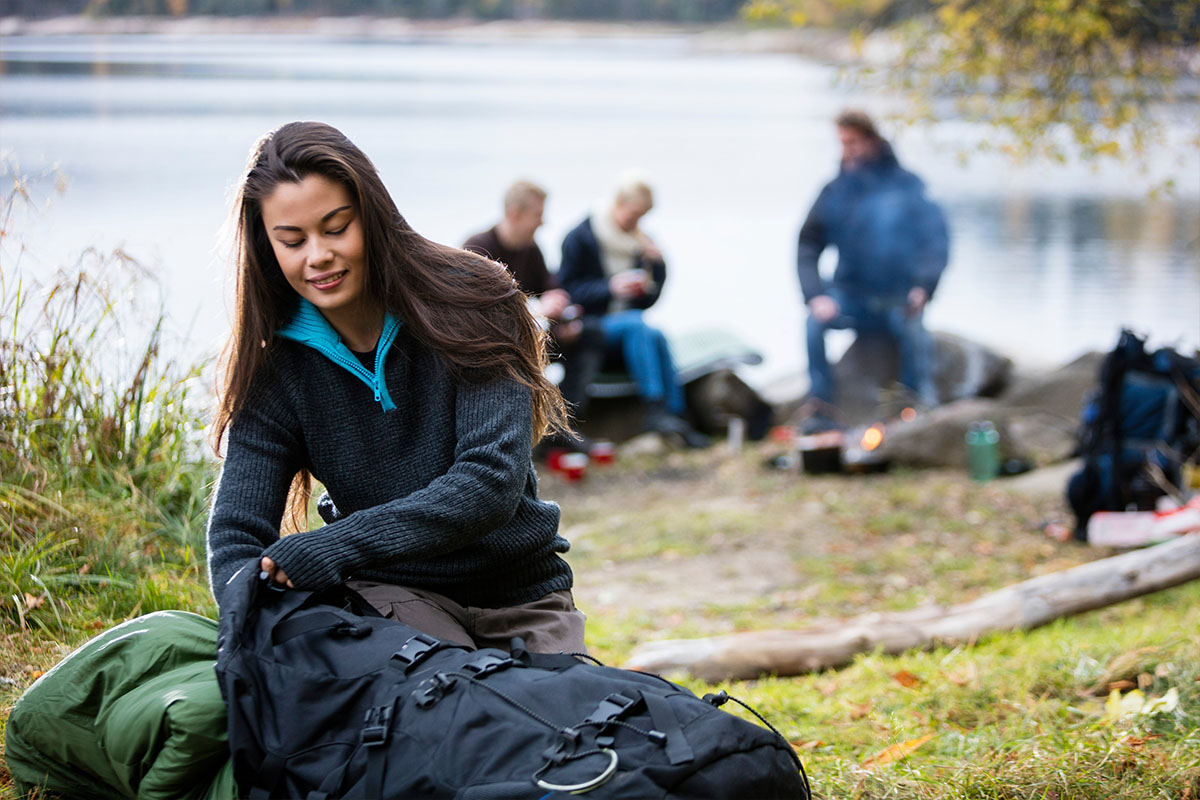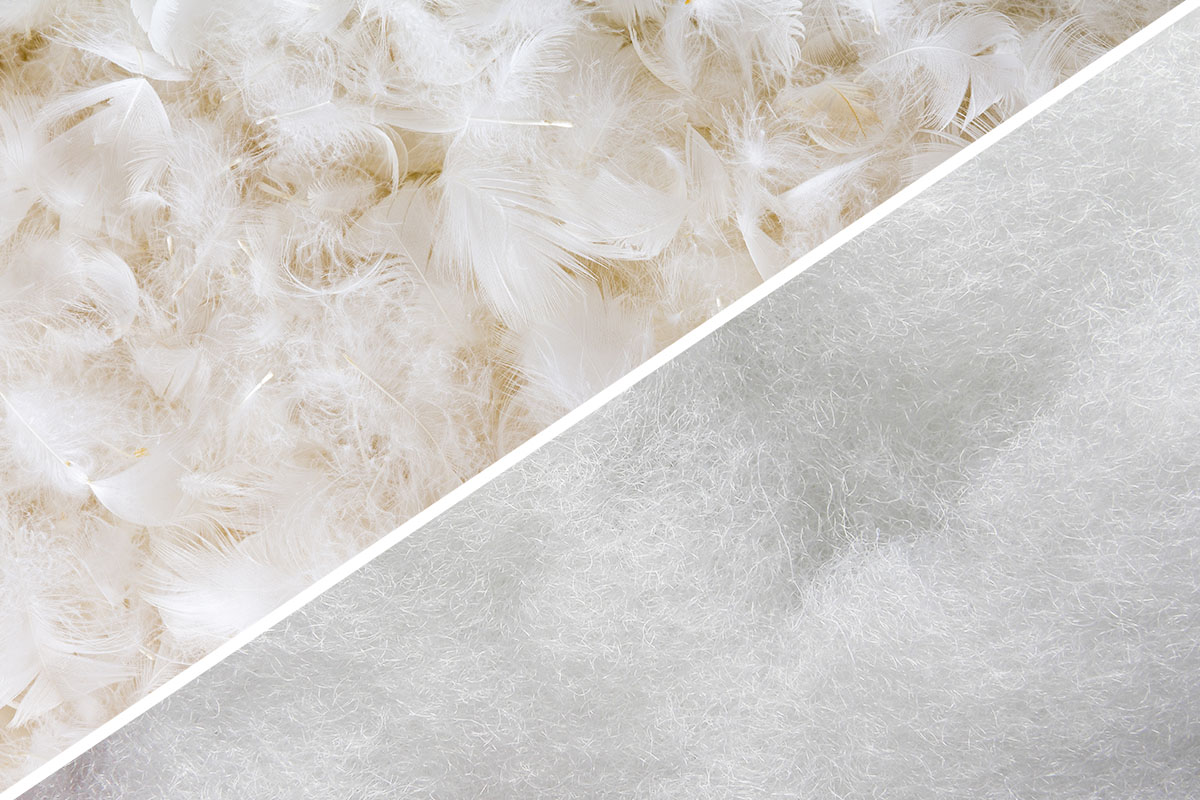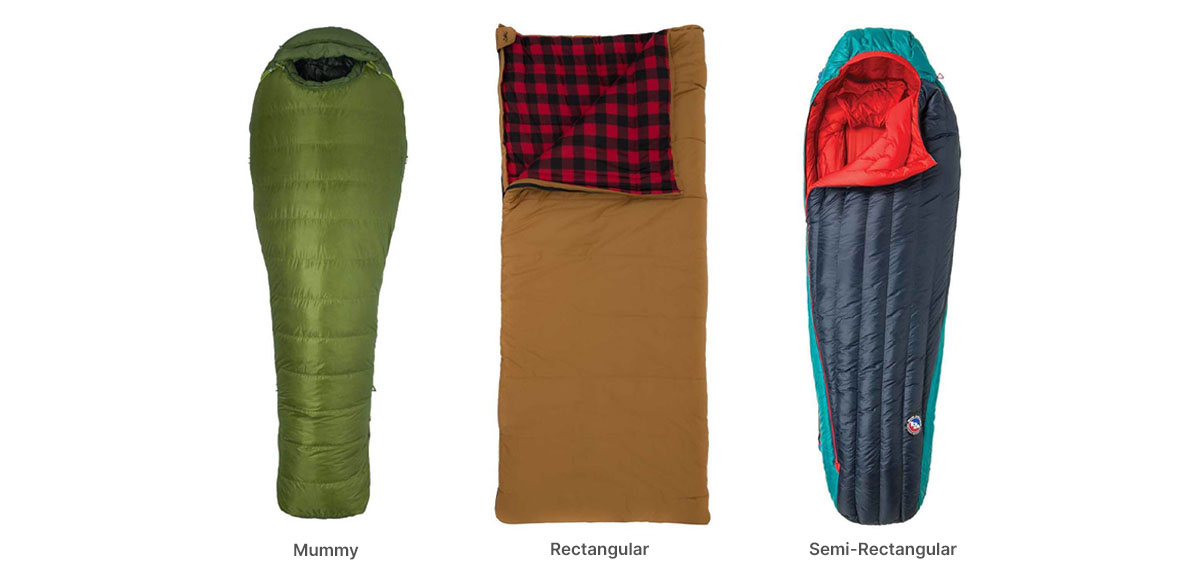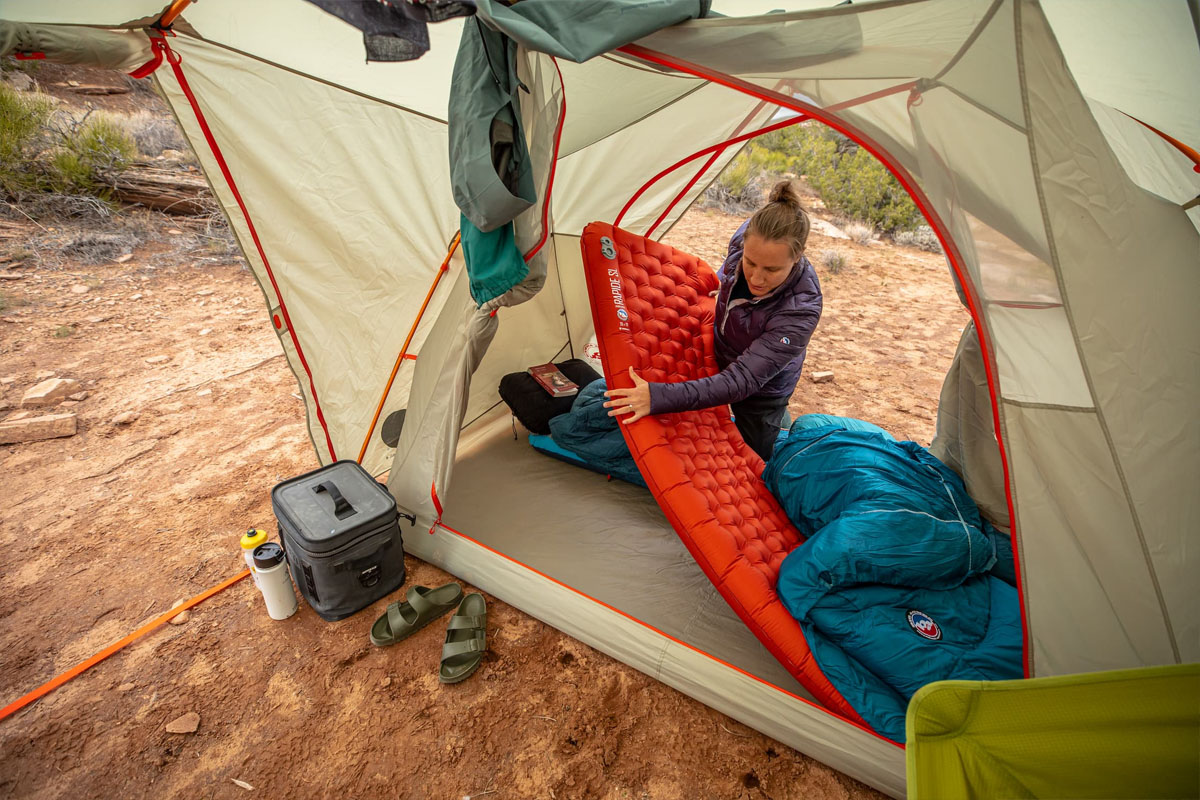How to Choose a
Backpacking Sleeping Bag

Serious backpackers are notorious for being borderline obsessive about the warmth-to-weight ratio of their sleeping bags. You can't sleep when you're too cold, but you will be stuck with a bag that weighs almost as much as your backpack with too much insulation. So you have to carefully consider a few characteristics of your sleeping bag to get the perfect ratio for you.
Considering weight is essential for a backpacking sleeping bag, but so is the temperature rating. You can get a lightweight sleeping bag that still keeps you warm, but you will need the correct type of insulation, fit, and accessories to make your sleep system as efficient as possible.
Let's start with the easiest thing to look for, the temperature rating.
Sleeping Bag Temperature Ratings

You can easily find a super light and thin sleeping bag that will be super easy to backpack with, but if the temperature drops a little, you will not have a good time in your tent or hammock. It can also be tough to look at or feel a sleeping bag and be able to tell how warm it can keep you without actually buying it and testing it yourself.
There is a standardized test that gives companies a temperature rating to put on their bag to make the process a little easier and let you get exactly what you are looking for. This gives you a number to look at, and you can easily use it to compare sleeping bags between brands or prices. These ratings are called ISO and EN. ISO is a bit newer than EN, but they are essentially the same.
To find a sleeping bag's temperature rating, the manufacturer identifies the lowest temperature at which a sleeping bag is designed to keep the user comfortably warm. I always suggest you buy a sleeping bag with a lower temperature rating than what you expect to encounter. I would rather be too warm and open my bag than be too cold with it fully zipped.
These tests give you a comfort and limit rating. The comfort number is the lowest temperature at which the average person can sleep comfortably in their sleeping bag. The limit rating describes the lowest temperature a "warm sleeper" can comfortably sleep in their sleeping bag. If you see a temperature estimate that does not include the words limit or comfort, it is likely a brand estimate and not an ISO or EN-tested estimate.
Sleeping Bag Weight
Insulation and shape are the two most significant factors when determining the weight of the sleeping bag. Insulation type, insulation fill power, and shape of the sleeping bag can all affect the weight. Even though these things can change from product to product, to compare apples to apples, you should always compare sleeping bags with a similar temperature rating when looking at bag weights.
Insulation is the most significant factor that changes the bag's weight, so let's start with the different types of fill, and then we'll talk about sleeping bag shapes.
Insulation Type

Choosing an insulation type is another crucial step in selecting your ideal sleeping bag. You basically have two options, down or synthetic insulation. Down is fairly standard. It is lightweight, easy to compress, and works well in dry conditions. Synthetic insulation is non-allergenic and dries quickly. Like wool, it also keeps you warm when it is wet.
To avoid cold spots, the bags are designed to distribute insulation all around you evenly. Down bags use various baffled constructions, while bags with synthetic insulation generally use a quilted pattern. Let's look at the two types and see which is best for you.
Down
If you want a light and super compressible material, then down is what you want. In the current market, down is used in a majority of products. Down is the way to go for an excellent weight to warmth ratio. It is very compressible, and with it tightly stuffed into your sleeping bag, you get a very effective layer of insulation without the bag being too thick. Down is also very durable and can last for decades if you take care of it.
The natural design of down makes it fluffy and traps a lot of air. This design is what makes it such an excellent insulator. Although when it gets wet, it loses the ability to trap air and is not nearly as good at insulating. That is why many sleeping bags that use down will also have a water-resistant layer around them. It is also not a bad idea to add your own water repellent treatment to your bag if you think it may get a little wet. If you want to take your down sleeping bag into any climate, you need to make sure that a bit of water isn't going to ruin your trip!
You can also find hydrophobic down, meaning it naturally repels water. However, this down is not nearly as good as it sounds. It is more or less down that will last slightly longer in wet conditions but will ultimately fail just like typical down. So the best way to waterproof a down sleeping bag is to make the bag itself waterproof and not the down.
To measure the quality of the down in your sleeping bag and how well it will insulate, we use a metric called fill power. The fill power number represents how good that particular type of down is at trapping warmth compared to its weight. The higher the fill power, the better the down is. Fill power can range anywhere from around 450 to 1000. It is calculated by how many cubic inches one ounce of down can fill in a testing device. So one ounce of 1000 fill power down can fill 1000 cubic inches of space. You can get the same warmth from 500 fill power down as 1000 fill power down, but it will take more down and weigh more overall.
Ethical Issues with Down
Down is an animal product, and it comes from waterfowl. Down is an underlayer of insulating feather-like material that keeps ducks and geese warm. To produce down products, there is no way around gathering it from farmed waterfowl. A lot of the down that is sold around the world comes from China, and a portion of it is also live-plucked from geese, which are then allowed to regrow their feathers and then are replucked.
Live plucking is a painful and ugly process. While many companies have policies in place (like Responsible Down Standard or Global Traceable Down Standard) to prevent the use of live-plucked down, their suppliers have been known to buy from live pluck facilities, and it is impossible to tell if the down was live-plucked or not.
Ethically sourced down is harvested from geese post-slaughter. Unfortunately, suppliers make less money this way because they only get one down harvest per bird, but this is the best way to do it. Assuming they live in humane conditions and have a painless slaughter, down harvested this way is no different than the leather products we get from cows and is more widely accepted.
Synthetic Insulation
Synthetic insulation is made to mimic down. It is mainly made of polyester fibers and is considerably cheaper than down. It mimics the overall structure of down and, therefore, its ability to trap air. However, it is not nearly as good at trapping air as down. Plus, it is also heavier and is less compressible. This means you will have a heavier sleeping bag that doesn't keep you as warm.
Where synthetic insulation excels is in wet climates. Down loses all of its warming ability when it gets wet, but synthetic insulation still holds up and keeps you warm. So you can take a sleeping bag made of synthetic insulation anywhere and not have to worry about it.
Unfortunately, synthetic insulation also falls short in terms of durability compared to down. Don't get me wrong, you can use both of them for many years, but in the end, the down product will last longer than the synthetic one. Thankfully the price offsets this, seeing as synthetic insulation is cheaper than down.
Synthetic insulation technology is improving every year. It continues to get closer to down, and many products have very impressive compressibility and warmth-to-weight ratios. Although as the market stands today, down is better than synthetic.
There are also a few down/synthetic blends out there that also perform highly. The best thing you can look at to quickly compare two products is the compressed volume specs, weight, and temperature rating.
Down vs Synthetic Insulation
| Down | Synthetic |
|---|---|
|
|
Sleeping Bag Shape

A bag with a sleek shape and a snug fit will be much lighter than a roomier bag, simply because less material is present. However, roomier bags may be more comfortable for certain sleepers. So based on the purpose of your bag, there are a few different shapes you can pick from.
The mummy bag has a slim cut with a contoured hood that is closeable for enhanced warmth. This bag will be a tight fit, and it will be more like an article of clothing than a bed. That is by design. The tighter fit will actually make you warmer throughout the night, and the smaller size means that there is less material, and it weighs less. So going with the mummy bag, you save weight and increase warmth, a win-win for backpackers.
The rectangular sleeping bag is one of the more traditional shapes. This is the kind of bag you may find in your parent's camping gear. They have been around for a long time and are a go-to for people who camp every now and again. Although as a backpacker, you are adding weight and removing warmth in exchange for a roomy sleeping bag. If you want more space when sleeping, this is the bag for you, although it is highly inefficient as a backpacker.
Somewhere in the middle of mummy and rectangular is semi-rectangular. These are also called "modified mummy" sleeping bag. The semi-rectangular designation is used to cover a variety of shapes that balance warmth and roominess. Semi-rectangular sleeping bags will also fall in the middle for weight. So if you like a little more room while you sleep but still want to be an efficient backpacker, the modified mummy is for you.
How to Get the Best Sleeping Bag Fit
The fit of a sleeping bag can be very different from brand to brand. It is just like jeans or shoes or shirts; if you usually wear a particular brand and then buy something from another brand in the same size, it doesn't fit the same way. Of course, brands have measurements on their bags to help you figure out which size to buy, but you should try one on in the store if you are comfortable with it.
If you do not want to try one on, rely on the brand's measurement suggestions for size. If you fall on the ends of their measurements, the smaller size will fit more snug but weigh less in your pack. If you do not want to bother with returning it if it's too small, go one size up.
While there are unisex sleeping bags, women who want a good fit are encouraged to get a women's fit sleeping bag. These bags are made to better fit a woman's figure, keeping you warmer than a unisex or men's sleeping bag. The primary difference between men's and women's sleeping bags is that the women's sleeping bags are a little shorter and narrower at the shoulders.
You Need a Sleeping Pad Too

There are a lot of variables between real-world warmth and the rating listed on your bag. For example, humidity, wind, type of shelter, ground conditions, clothing, and even personal preference all play a role. To generally optimize your sleeping experience while backpacking, though, you should look to create your ideal sleep system. A sleep system is made of three components: your sleeping bag, sleeping pad, and clothing.
For example, pairing a sleeping bag with a less-insulated pad at colder temps might limit the effectiveness of your bag. After all, a sleeping bag's test rating is based on a person wearing long underwear and socks sleeping on a pad with an R-value of 5.5.
The table below shows the recommended sleep system combinations based on your expected nighttime low, R-Value, and sleeping bag temperature rating.
| Conditions | Warm | Cool | Cold | Extreme |
| Expected Night Low | 50 °F | 32 °F | 20 °F | 0 °F |
| Pad R-Value Range | Under 2 | 2 - 3.9 | 4 - 5.4 | 5.5+ |
| Bag Temperature Rating | 30 °F or lower | 20 °F or lower | 15 °F or lower | 0 °F or lower |
If you're a warm sleeper, use the "lower limit" for the bag's temperature rating. If you're a cold sleeper, use its comfort rating.
Sleeping Bag Construction | Baffles & Denier
Sleeping bags are made so that the insulation is not allowed to slide around and leave an area without insulation. If insulation slides around, it creates cold spots and is not ideal for serious backpackers. So to make sure this does not happen, companies have a few different strategies for keeping the insulation where it is supposed to be. Sleeping bags with synthetic insulation typically do not have baffles because the insulation is continuous fiber. This means it is all one big piece of insulation, whereas down is a whole bunch of separate under feathers.
Sewn-through baffles are the most common in down sleeping bags. They sew a thread through the interior and exterior fabrics in order to keep everything together. This is the simplest and cheapest way to do it, but it is also not very efficient, and these bags will not keep you as warm.
Vertical baffles run up and down a sleeping bag. These baffles are essentially keeping the insulation in a column and does not allow it to move side to side. Using these kinds of baffles makes it easy for the company to construct hoods and toe boxes, and they are reasonably warm.
Horizontal baffles are the best you can get with down sleeping bags. These baffles will help give you a higher warmth-to-weight ratio and allow for some insulation adjustability. You can really move the down around in these baffles with a few shakes, so if it is colder out, move some down to the top, and on warmer nights, you can move it to the bottom to act as a cushion. These baffles are also the hardest to sew for manufacturers, so they are typically more expensive.
Some sleeping bags also come with secondary baffles. Neck baffles are one example. They are designed to keep air from entering the top of the bag when you are in it, thus making it warmer if you have a sleeping pad under you. You will also find draft tubes on some bags, which are essentially extra baffles around the zipper that reduce heat loss. These additional baffles are really only needed if you are sleeping in frigid temperatures.
Fiber Denier
The material the sleeping bag is made out of is also important. It needs to be strong enough to hold everything together. After all, the last thing you want is for your sleeping bag to get a tear in it when you are hiking or setting it up for the night. The material used is rated based on its denier, and you will see it as a number followed by a D. The higher the number, the stronger the fabric.
Denier is a measurement that describes the linear density of the fiber, but it's not everything. The overall strength of the fiber also depends on how it is put together. A nicely woven 5D material can outperform a poorly woven 10D material, but probably not a 25D. Higher denier sleeping bags are generally more durable, but 10D or 30D sleeping bags are still relatively easy to tear.
This is one place synthetic bags have an advantage. If you tear open a down bag, you are going to lose insulation. If you rip a bag with synthetic insulation, you will get a good look at a long sheet of continuous fiber material, and none of it will come out.
Routine Sleeping Bag Maintenance
The best thing you can do for your sleeping bag to make sure it performs over time is to store it uncompressed; each bag normally comes with a loose bag that will work fine for storage. Keeping the down or synthetic fiber uncompressed will make it last much longer and perform better over time. Once you buy your sleeping bag, make sure you have somewhere dry to store it and consider hanging it unrolled.
If you get your down sleeping bag wet, it is not the end of the world. You will be cold at night, but when your trip is over, and you can properly dry out your bag, it will be fine the next time you go out. It is the same story with synthetic bags, just make sure it's nice and dry before the next trip, and there will be no long-term effects.
Washing your bag now and again is also a good idea. You just have to make sure that you get some soap that is okay to use with down products and that it gets good and dry when you are done. Down can also clump up when you wash it, so before you store it again, make sure to even all the insulation out.
Additional Sleeping Bag Features
Draft-blocking features: To prevent warm air from escaping, some bags feature draft tubes that run the length of the sleeping bag. Yokes can be found at the top of the bag, preventing warm air from escaping.
Sleeping pad compatibility: On some newer bags, the bottom insulation is replaced with a sleeve that fits a sleeping pad (typically sold separately). Pad loops also allow you to use straps to connect a sleeping pad to your bag.
Anti-snag zipper: Snagging your zipper isn't just annoying; it causes unnecessary wear and tear. Some bags feature shields around the zipper with a guard along its entire length to prevent this. Other bags may come with a zipper cover.
Stash pocket: Often found on the chest panel of the bag, a stash pocket is useful for keeping small personal items.
Sleeping bag hood: Hoods offer additional warmth when cinched tightly around the sleeper's head. You may find differentiated drawcords on some bags, which feature different thicknesses. This way, users can quickly determine which cord adjusts your neck fit and which adjusts your hood opening.
Left or right zip: This only matters if you are a couple looking to zip two bags together. One person will need a left-hand zip bag, and the other will need a right-hand zip bag. They must also be the same type of zipper. If a brand makes the same bag in men's and women's varieties, the men's will generally be a left zip, and the women's will be a right zip. You can also buy double bags specifically designed for two sleepers.
Pillow pocket: This clever feature is a pocket in which users can stuff clothes to create a pillow. This isn't a must-have, you can bring a pillow from home, but that may be cumbersome while backpacking.